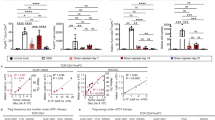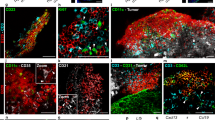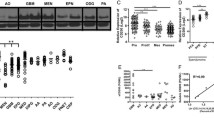Abstract
Regulatory T cells (Tregs) are potently immunosuppressive cells that accumulate within the glioma microenvironment. The reduction in their function and/or trafficking has been previously shown to enhance survival in preclinical models of glioma. Glucocorticoid-induced TNFR-related protein (GITR) is a tumor necrosis factor superfamily receptor enriched on Tregs that has shown promise as a target for immunotherapy. An agonistic antibody against GITR has been demonstrated to inhibit Tregs in a number of models and has only been recently addressed in glioma. In this study, we examined the modality of the antibody function at the tumor site as opposed to the periphery as the blood–brain barrier prevents efficient antibody delivery to brain tumors. Mice harboring established GL261 tumors were treated with anti-GITR monotherapy and were shown to have a significant increase in overall survival (p < 0.01) when antibodies were injected directly into the glioma core, whereas peripheral antibody treatment only had a modest effect. Peripheral treatment resulted in a significant decrease in granzyme B (GrB) expression by Tregs, whereas intratumoral treatment resulted in both a decrease in GrB expression by Tregs and their selective depletion, which was largely mediated by FcγR-mediated destruction. We also discovered that anti-GITR treatment results in the enhanced survival and functionality of dendritic cells (DCs)—a previously unreported effect of this immunotherapy. In effect, this study demonstrates that the targeting of GITR is a feasible and noteworthy treatment option for glioma, but is largely dependent on the anatomical location in which the antibodies are delivered.






Similar content being viewed by others
Abbreviations
- APC:
-
Allophycocyanin
- BMDC:
-
Bone marrow dendritic cell
- CNS:
-
Central nervous system
- FcγR:
-
Fc gamma receptor
- GBM:
-
Glioblastoma multiforme
- GITR:
-
Glucocorticoid-induced TNFR-related protein
- GrB:
-
Granzyme B
- Prf1:
-
Perforin 1
- TME:
-
Tumor microenvironment
- Treg:
-
Regulatory T cell
References
Heimberger AB, Sampson JH (2011) Immunotherapy coming of age: What will it take to make it standard of care for glioblastoma? Neuro-Oncology 13(1):3–13. doi:10.1093/neuonc/noq169
Vom Berg J, Vrohlings M, Haller S, Haimovici A, Kulig P, Sledzinska A, Weller M, Becher B (2013) Intratumoral IL-12 combined with CTLA-4 blockade elicits T cell-mediated glioma rejection. J Exp Med 210(13):2803–2811. doi:10.1084/jem.20130678
Aldrich WA, Ren C, White AF, Zhou SZ, Kumar S, Jenkins CB, Shaw DR, Strong TV, Triozzi PL, Ponnazhagan S (2006) Enhanced transduction of mouse bone marrow-derived dendritic cells by repetitive infection with self-complementary adeno-associated virus 6 combined with immunostimulatory ligands. Gene Ther 13(1):29–39. doi:10.1038/sj.gt.3302601
Zeng J, See AP, Phallen J, Jackson CM, Belcaid Z, Ruzevick J, Durham N, Meyer C, Harris TJ, Albesiano E, Pradilla G, Ford E, Wong J, Hammers HJ, Mathios D, Tyler B, Brem H, Tran PT, Pardoll D, Drake CG, Lim M (2013) Anti-PD-1 blockade and stereotactic radiation produce long-term survival in mice with intracranial gliomas. Int J Radiat Oncol Biol Phys 86(2):343–349. doi:10.1016/j.ijrobp.2012.12.025
Wainwright DA, Chang AL, Dey M, Balyasnikova IV, Kim C, Tobias AL, Cheng Y, Kim J, Zhang L, Qiao J, Han Y, Lesniak MS (2014) Durable therapeutic efficacy utilizing combinatorial blockade against IDO, CTLA-4 and PD-L1 in mice with brain tumors. Clin Cancer Res 20(20):5290–5301. doi:10.1158/1078-0432.CCR-14-0514
Wainwright DA, Balyasnikova IV, Chang AL, Ahmed AU, Moon KS, Auffinger B, Tobias AL, Han Y, Lesniak MS (2012) IDO expression in brain tumors increases the recruitment of regulatory T cells and negatively impacts survival. Clin Cancer Res 18(22):6110–6121. doi:10.1158/1078-0432.CCR-12-2130
Vega EA, Graner MW, Sampson JH (2008) Combating immunosuppression in glioma. Future Oncol 4(3):433–442. doi:10.2217/14796694.4.3.433
Lindau D, Gielen P, Kroesen M, Wesseling P, Adema GJ (2013) The immunosuppressive tumour network: myeloid-derived suppressor cells, regulatory T cells and natural killer T cells. Immunology 138(2):105–115. doi:10.1111/imm.12036
Ostrand-Rosenberg S, Sinha P (2009) Myeloid-derived suppressor cells: linking inflammation and cancer. J Immunol 182(8):4499–4506. doi:10.4049/jimmunol.0802740
Chang CH, Qiu J, O’Sullivan D, Buck MD, Noguchi T, Curtis JD, Chen QY, Gindin M, Gubin MM, van der Windt GJW, Tonc E, Schreiber RD, Pearce EJ, Pearce EL (2015) Metabolic competition in the tumor microenvironment is a driver of cancer progression. Cell 162(6):1229–1241. doi:10.1016/j.cell.2015.08.016
Maes W, Verschuere T, Van Hoylandt A, Boon L, Van Gool S (2013) Depletion of regulatory T cells in a mouse experimental glioma model through anti-CD25 treatment results in the infiltration of non-immunosuppressive myeloid cells in the brain. Clin Dev Immunol 2013:952469. doi:10.1155/2013/952469
Wainwright DA, Dey M, Chang A, Lesniak MS (2013) Targeting tregs in malignant brain cancer: overcoming IDO. Front Immunol 4:116. doi:10.3389/fimmu.2013.00116
Jordan JT, Sun W, Hussain SF, DeAngulo G, Prabhu SS, Heimberger AB (2008) Preferential migration of regulatory T cells mediated by glioma-secreted chemokines can be blocked with chemotherapy. Cancer Immunol Immunother 57(1):123–131. doi:10.1007/s00262-007-0336-x
Hori S, Nomura T, Sakaguchi S (2003) Control of regulatory T cell development by the transcription factor Foxp3. Science 299(5609):1057–1061. doi:10.1126/science.1079490
Mellman I, Coukos G, Dranoff G (2011) Cancer immunotherapy comes of age. Nature 480(7378):480–489. doi:10.1038/nature10673
Wainwright DA, Sengupta S, Han Y, Lesniak MS (2011) Thymus-derived rather than tumor-induced regulatory T cells predominate in brain tumors. Neuro Oncol 13(12):1308–1323. doi:10.1093/neuonc/nor134
Prins RM, Graf MR, Merchant RE, Black KL, Wheeler CJ (2003) Thymic function and output of recent thymic emigrant T cells during intracranial glioma progression. J Neurooncol 64(1–2):45–54. doi:10.1007/BF02700019
Dey M, Chang AL, Wainwright DA, Ahmed AU, Han Y, Balyasnikova IV, Lesniak MS (2014) Heme oxygenase-1 protects regulatory T cells from hypoxia-induced cellular stress in an experimental mouse brain tumor model. J Neuroimmunol 266(1–2):33–42. doi:10.1016/j.jneuroim.2013.10.012
El Andaloussi A, Han Y, Lesniak MS (2006) Prolongation of survival following depletion of CD4+CD25+ regulatory T cells in mice with experimental brain tumors. J Neurosurg 105(3):430–437. doi:10.3171/jns.2006.105.3.430
Fecci PE, Sweeney AE, Grossi PM, Nair SK, Learn CA, Mitchell DA, Cui XY, Cummings TJ, Bigner DD, Gilboa E, Sampson JH (2006) Systemic anti-CD25 monoclonal antibody administration safely enhances immunity in murine glioma without eliminating regulatory T cells. Clin Cancer Res 12(14):4294–4305. doi:10.1158/1078-0432.Ccr-06-0053
Whiteside TL (2014) Regulatory T cell subsets in human cancer: Are they regulating for or against tumor progression? Cancer Immunol Immun 63(1):67–72. doi:10.1007/s00262-013-1490-y
Heimberger AB, Kong LY, Abou-Ghazal M, Reina-Ortiz C, Yang DS, Wei J, Qiao W, Schmittling RJ, Archer GE, Sampson JH, Hiraoka N, Priebe W, Fuller GN, Sawaya R (2009) The role of Tregs in human glioma patients and their inhibition with a novel STAT-3 inhibitor. Clin Neurosurg 56:98–106. doi:10.1227/01.neu.0000333524.54656.42
Sonabend AM, Rolle CE, Lesniak MS (2008) The role of regulatory T cells in malignant glioma. Anticancer Res 28(2B):1143–1150
El Andaloussi A, Lesniak MS (2007) CD4(+)CD25(+)FoxP3(+) T-cell infiltration and heme oxygenase-1 expression correlate with tumor grade in human gliomas. J Neuro-Oncol 83(2):145–152. doi:10.1007/s11060-006-9314-y
Thomas AA, Fisher JL, Rahme GJ, Hampton TH, Baron U, Olek S, Schwachula T, Rhodes CH, Gui J, Tafe LJ, Tsongalis GJ, Lefferts JA, Wishart H, Kleen J, Miller M, Whipple CA, de Abreu FB, Ernstoff MS, Fadul CE (2015) Regulatory T cells are not a strong predictor of survival for patients with glioblastoma. Neuro Oncol 17(6):801–809. doi:10.1093/neuonc/nou363
Sayour EJ, McLendon P, McLendon R, De Leon G, Reynolds R, Kresak J, Sampson JH, Mitchell DA (2015) Increased proportion of FoxP3+ regulatory T cells in tumor infiltrating lymphocytes is associated with tumor recurrence and reduced survival in patients with glioblastoma. Cancer Immunol Immun 64(4):419–427. doi:10.1007/s00262-014-1651-7
Yue Q, Zhang X, Ye HX, Wang Y, Du ZG, Yao Y, Mao Y (2014) The prognostic value of Foxp3+ tumor-infiltrating lymphocytes in patients with glioblastoma. J Neuro-Oncol 116(2):251–259. doi:10.1007/s11060-013-1314-0
Jacobs JFM, Idema AJ, Bol KF, Grotenhuis JA, de Vries IJM, Wesseling P, Adema GJ (2010) Prognostic significance and mechanism of Treg infiltration in human brain tumors. J Neuroimmunol 225(1–2):195–199. doi:10.1016/j.jneuroim.2010.05.020
Smyth MJ, Ngiow SF, Teng MWL (2014) Targeting regulatory T cells in tumor immunotherapy. Immunol Cell Biol 92(6):473–474. doi:10.1038/icb.2014.33
Litzinger MT, Fernando R, Curiel TJ, Grosenbach DW, Schlom J, Palena C (2007) IL-2 immunotoxin denileukin diftitox reduces regulatory T cells and enhances vaccine-mediated T-cell immunity. Blood 110(9):3192–3201. doi:10.1182/blood-2007-06-094615
Ko K, Yamazaki S, Nakamura K, Nishioka T, Hirota K, Yamaguchi T, Shimizu J, Nomura T, Chiba T, Sakaguchi S (2005) Treatment of advanced tumors with agonistic anti-GITR mAb and its effects on tumor-infiltrating Foxp3+CD25+CD4+ regulatory T cells. J Exp Med 202(7):885–891. doi:10.1084/jem.20050940
Hodi FS, O’Day SJ, McDermott DF, Weber RW, Sosman JA, Haanen JB, Gonzalez R, Robert C, Schadendorf D, Hassel JC, Akerley W, van den Eertwegh AJ, Lutzky J, Lorigan P, Vaubel JM, Linette GP, Hogg D, Ottensmeier CH, Lebbe C, Peschel C, Quirt I, Clark JI, Wolchok JD, Weber JS, Tian J, Yellin MJ, Nichol GM, Hoos A, Urba WJ (2010) Improved survival with ipilimumab in patients with metastatic melanoma. N Engl J Med 363(8):711–723. doi:10.1056/NEJMoa1003466
Tone Y, Kidani Y, Ogawa C, Yamamoto K, Tsuda M, Peter C, Waldmann H, Tone M (2014) Gene expression in the gitr locus is regulated by NF-kappa B and Foxp3 through an enhancer. J Immunol 192(8):3915–3924. doi:10.4049/jimmunol.1302174
Fecci PE, Ochiai H, Mitchell DA, Grossi PM, Sweeney AE, Archer GE, Cummings T, Allison JP, Bigner DD, Sampson JH (2007) Systemic CTLA-4 blockade ameliorates glioma-induced changes to the CD4(+) T cell compartment without affecting regulatory T-cell function. Clin Cancer Res 13(7):2158–2167. doi:10.1158/1078-0432.Ccr-06-2070
Naidoo J, Page DB, Wolchok JD (2014) Immune modulation for cancer therapy. Br J Cancer 111(12):2214–2219. doi:10.1038/bjc.2014.348
Ronchetti S, Zollo O, Bruscoli S, Agostini M, Bianchini R, Nocentini G, Ayroldi E, Riccardi C (2004) GITR, a member of the TNF receptor superfamily, is costimulatory to mouse T lymphocyte subpopulations. Eur J Immunol 34(3):613–622. doi:10.1002/eji.200324804
Lahey TP, Loisel SD, Wieland-Alter W (2007) Glucocorticoid-induced tumor necrosis factor receptor family-related protein triggering enhances HIV-specific CD4(+) T cell cytokine secretion and protects HIV-specific CD4(+) T cells from apoptosis. J Infect Dis 196(1):43–49. doi:10.1086/518613
Schaer DA, Budhu S, Liu CL, Bryson C, Malandro N, Cohen A, Zhong H, Yang X, Houghton AN, Merghoub T, Wolchok JD (2013) GITR pathway activation abrogates tumor immune suppression through loss of regulatory T-cell lineage stability. Cancer Immunol Res 1(5):320–331. doi:10.1158/2326-6066.Cir-13-0086
Patel MA, Kim JE, Theodros D, Tam A, Velarde E, Kochel CM, Francica B, Nirschl TR, Ghasemzadeh A, Mathios D, Harris-Bookman S, Jackson CC, Jackson C, Ye X, Tran PT, Tyler B, Coric V, Selby M, Brem H, Drake CG, Pardoll DM, Lim M (2016) Agonist anti-GITR monoclonal antibody and stereotactic radiation induce immune-mediated survival advantage in murine intracranial glioma. J Immunother Cancer 4:28. doi:10.1186/s40425-016-0132-2
Lampson LA (2011) Monoclonal antibodies in neuro-oncology: getting past the blood–brain barrier. MAbs 3(2):153–160. doi:10.4161/mabs.3.2.14239
Tario JD, Humphrey K, Bantly AD, Muirhead KA, Moore JS, Wallace PK (2012) Optimized staining and proliferation modeling methods for cell division monitoring using cell tracking dyes. J Vis Exp 70:e4287. doi:10.3791/4287
Bettelli E, Carrier Y, Gao W, Korn T, Strom TB, Oukka M, Weiner HL, Kuchroo VK (2006) Reciprocal developmental pathways for the generation of pathogenic effector TH17 and regulatory T cells. Nature 441(7090):235–238. doi:10.1038/nature04753
Choi BD, Gedeon PC, Sanchez-Perez L, Bigner DD, Sampson JH (2013) Regulatory T cells are redirected to kill glioblastoma by an EGFRvIII-targeted bispecific antibody. Oncoimmunology 2(12):e26757. doi:10.4161/onci.26757
Szajnik M, Czystowska M, Szczepanski MJ, Mandapathil M, Whiteside TL (2010) Tumor-derived microvesicles induce, expand and up-regulate biological activities of human regulatory T cells (Treg). PLoS One 5(7):e11469. doi:10.1371/journal.pone.0011469
Gondek DC, Lu LF, Quezada SA, Sakaguchi S, Noelle RJ (2005) Cutting edge: contact-mediated suppression by CD4+CD25+ regulatory cells involves a granzyme B-dependent, perforin-independent mechanism. J Immunol 174(4):1783–1786. doi:10.4049/jimmunol.174.4.1783
Ji HB, Liao G, Faubion WA, Abadia-Molina AC, Cozzo C, Laroux FS, Caton A, Terhorst C (2004) Cutting edge: the natural ligand for glucocorticoid-induced TNF receptor-related protein abrogates regulatory T cell suppression. J Immunol 172(10):5823–5827. doi:10.4049/jimmunol.172.10.5823
Bulliard Y, Jolicoeur R, Windman M, Rue SM, Ettenberg S, Knee DA, Wilson NS, Dranoff G, Brogdon JL (2013) Activating Fc gamma receptors contribute to the antitumor activities of immunoregulatory receptor-targeting antibodies. J Exp Med 210(9):1685–1693. doi:10.1084/jem.20130573
Vecchiarelli A, Pericolini E, Gabrielli E, Agostini M, Bistoni F, Nocentini G, Cenci E, Riccardi C (2009) The GITRL-GITR system alters TLR-4 expression on DC during fungal infection. Cell Immunol 257(1–2):13–22. doi:10.1016/j.cellimm.2009.02.001
Sallusto F, Lanzavecchia A (1994) Efficient presentation of soluble-antigen by cultured human dendritic cells is maintained by granulocyte-macrophage colony-stimulating factor plus interleukin-4 and down-regulated by tumor-necrosis-factor-alpha. J Exp Med 179(4):1109–1118. doi:10.1084/jem.179.4.1109
Lu L, Xu X, Zhang B, Zhang R, Ji H, Wang X (2014) Combined PD-1 blockade and GITR triggering induce a potent antitumor immunity in murine cancer models and synergizes with chemotherapeutic drugs. J Transl Med 12:36. doi:10.1186/1479-5876-12-36
Sakuishi K, Apetoh L, Sullivan JM, Blazar BR, Kuchroo VK, Anderson AC (2010) Targeting Tim-3 and PD-1 pathways to reverse T cell exhaustion and restore anti-tumor immunity. J Exp Med 207(10):2187–2194. doi:10.1084/jem.20100643
Yang L, Guo G, Niu XY, Liu J (2015) Dendritic cell-based immunotherapy treatment for glioblastoma multiforme. Biomed Res Int 2015:717530. doi:10.1155/2015/717530
Sakaguchi S, Wing K, Onishi Y, Prieto-Martin P, Yamaguchi T (2009) Regulatory T cells: How do they suppress immune responses? Int Immunol 21(10):1105–1111. doi:10.1093/intimm/dxp095
Esparza EM, Arch RH (2005) Glucocorticoid-induced TNF receptor functions as a costimulatory receptor that promotes survival in early phases of T cell activation. J Immunol 174(12):7869–7874. doi:10.4049/jimmunol.174.12.7869
Acknowledgments
The authors wish to thank Dr. Atique Ahmed and Joshua Robert Kane for critical review of the manuscript. The work was supported by NIH National Cancer Institute R01CA122930, R01 NS093903 Grants to Maciej S. Lesniak and NIH/National Cancer Institute T32 CA080621-12 to Jason Miska.
Author information
Authors and Affiliations
Corresponding author
Ethics declarations
Conflict of interest
The authors declare that they have no conflict of interest.
Additional information
Jason Miska and Aida Rashidi have contributed equally to this work.
Electronic supplementary material
Below is the link to the electronic supplementary material.
Rights and permissions
About this article
Cite this article
Miska, J., Rashidi, A., Chang, A.L. et al. Anti-GITR therapy promotes immunity against malignant glioma in a murine model. Cancer Immunol Immunother 65, 1555–1567 (2016). https://doi.org/10.1007/s00262-016-1912-8
Received:
Accepted:
Published:
Issue Date:
DOI: https://doi.org/10.1007/s00262-016-1912-8




